Equations can be in written in a variety of ways including a) numerical expression form such as "the sum of 6 and 2". b) algebraic expressions such as "6 + x = 8". In most cases we are looking for a variable that is unknown. The series of worksheets and lessons that you will find below will help students not only be able to solve for variables in equations, but we will make progress towards writing your own equations for situations that are described for you. This will lead to all the into an algebraic thinking mindset. The worksheet topics are arranged by difficult. It starts with the ground floor of single step equations. The worksheets will cover how to approach solving complex equations as well. Click on a topic below to get working with your equation worksheets.
Equation Worksheet Categories
Click any of the images or words below to print out the equation sheets.
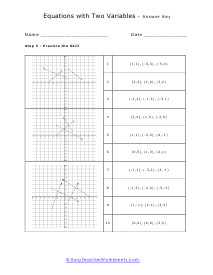
Single Step Equations
These problems have one variable and really focus on cancelling out a single operation.
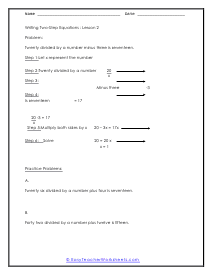
Two Step Equations
This is the next progression in algebra. It will normally require to first cancel out an operation and then follow it with an operation to free the variable and get it by itself.

Addition Principles
This is the fundamental principle that says we can perform any operation we so desire on an equation as long as we apply to both sides of the equals symbol.

Addition and Subtraction Equations
These are free of multiplication and division. The focus of these worksheets are to work with simple operators and focus on major concepts.

Direct Variations
You will find this in equations that have variables that are proportional to one another. The goal of these worksheets is to determine if the variables have a relationship and to be able to define it.

Equations With Decimals
Just because a value is a decimal does not change how we treat it. Help students get comfortable with these decimal values as the move things from one side to the other.

Evaluating Formulas
We explore the steps you should take when processing this skill. You will work out problems and identify the value of fixed variables.

Literal Equations
The variables in these equations are place holder that represent real values. A bit of a change for variables.

Mixed Steps For Solving Equations
These provide you with a nice way to review and go over what you have learned. This includes a series of worksheets that have simple and difficult problems on the same page.
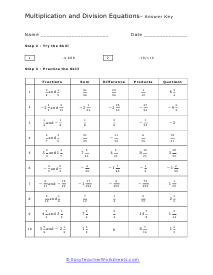

Radical Equations
Any equations that have radicals values embedded within them. Learn how to unwrap problems that include them.

Rational Equations
These all contain a fractional value and the unknown variable is always found in the numerator.
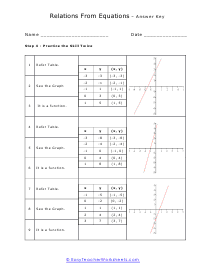
Relations From Equations
Learn how to interpret what a math statement means and how thing interrelate.
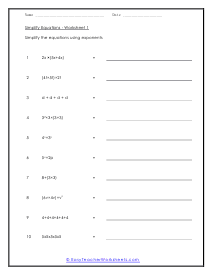

Solving Exponential Equations
Exponents have the ability to frightened students. These worksheets will change their mind in the right way.
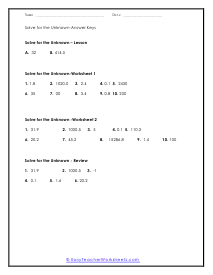
Solving Equations
We show you the process and help you better understand how to get a rhythm with these types of problems.

Solving Fractional Equations
Fractions can throw a monkey wrench into any situation especially math problems.

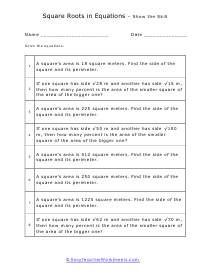
Square Roots in Equations
How do you best approach these problems? We ponder this and get next level with it for you.

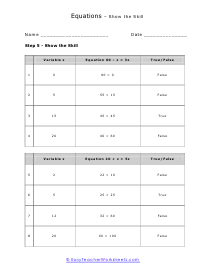

Variables on Both Sides
We show you what to do when you are dealing with multiple scattered variables that you cannot combine.

What are Math Equations?
A math equation is a statement that simply says two things are equal. You can differentiate expressions from equations because every equation contains an equals symbol (=). The premise of these mathematical statements is that this equals that. The left side is equal to the right side.
Example: 3 + x = 8
What Are the Parts of an Equation?
Equal Sign- As we already stated, equations are easily identifiable because they always have an equal sign.
Terms- These are the individual numbers, variables, or the compilation of both. Each piece that is not the equal sign or an operator are considered terms.
Constants- Numbers or variable by themselves that do not interact.
Arithmetic Operators- These are math operations which are normal composed of +, -, x, or ÷.
Coefficients- These are constants that are multiplied by a variable.
Exponents- These indicate the number of times a term is multiplied by itself.
Algebra is the first time that some concepts may be over the heads of your students. If you follow a consistent routine with how you approach problems, it can be much easier for you to handle. The first thing you should do with any equation is look for like terms and just combine those bad boys right away. Once everything is combined start to work on getting the variable by itself. You can do this by applying the same operation to both sides of the equation to cancel out status quo operators. From here on it generally comes down to basic math skills. You can remember the concept of equal by looking at the root of the word in "equations" (equa or equal). Equations are simply short-hand math. They are great methods for setting up and even solving common everyday math problems. We write math phrases using variables which can be known or unknown values. The anatomy of a basic equation consists of two parts which are variables and constants. In the problem 9 + x = 11, the integers (9 and 11) are constants and the unknown (x) is the variable.

